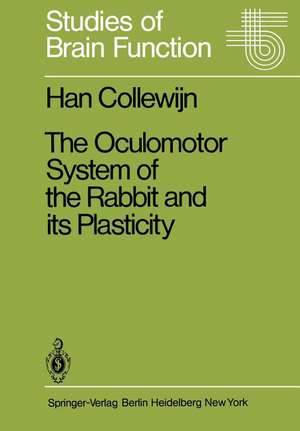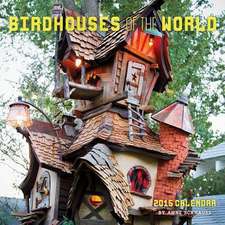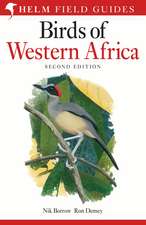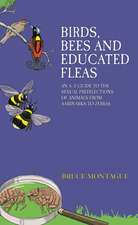The Oculomotor System of the Rabbit and Its Plasticity: Studies of Brain Function, cartea 5
Autor H. Collewijnen Limba Engleză Paperback – 25 dec 2011
Din seria Studies of Brain Function
- 15%
 Preț: 631.72 lei
Preț: 631.72 lei - 15%
 Preț: 636.45 lei
Preț: 636.45 lei - 15%
 Preț: 647.73 lei
Preț: 647.73 lei - 15%
 Preț: 584.58 lei
Preț: 584.58 lei -
 Preț: 383.33 lei
Preț: 383.33 lei - 18%
 Preț: 784.13 lei
Preț: 784.13 lei -
 Preț: 394.51 lei
Preț: 394.51 lei - 15%
 Preț: 641.71 lei
Preț: 641.71 lei - 15%
 Preț: 640.06 lei
Preț: 640.06 lei - 15%
 Preț: 641.71 lei
Preț: 641.71 lei - 15%
 Preț: 639.41 lei
Preț: 639.41 lei - 15%
 Preț: 642.03 lei
Preț: 642.03 lei - 18%
 Preț: 721.63 lei
Preț: 721.63 lei - 15%
 Preț: 632.37 lei
Preț: 632.37 lei - 15%
 Preț: 638.24 lei
Preț: 638.24 lei - 15%
 Preț: 639.41 lei
Preț: 639.41 lei
Preț: 640.24 lei
Preț vechi: 753.22 lei
-15% Nou
Puncte Express: 960
Preț estimativ în valută:
122.52€ • 126.58$ • 101.92£
122.52€ • 126.58$ • 101.92£
Carte tipărită la comandă
Livrare economică 19 martie-02 aprilie
Preluare comenzi: 021 569.72.76
Specificații
ISBN-13: 9783642816291
ISBN-10: 3642816290
Pagini: 256
Ilustrații: IX, 240 p. 28 illus.
Dimensiuni: 170 x 244 x 13 mm
Greutate: 0.41 kg
Ediția:Softcover reprint of the original 1st ed. 1981
Editura: Springer Berlin, Heidelberg
Colecția Springer
Seria Studies of Brain Function
Locul publicării:Berlin, Heidelberg, Germany
ISBN-10: 3642816290
Pagini: 256
Ilustrații: IX, 240 p. 28 illus.
Dimensiuni: 170 x 244 x 13 mm
Greutate: 0.41 kg
Ediția:Softcover reprint of the original 1st ed. 1981
Editura: Springer Berlin, Heidelberg
Colecția Springer
Seria Studies of Brain Function
Locul publicării:Berlin, Heidelberg, Germany
Public țintă
ResearchCuprins
1 Introduction.- 1.1 Orientation of the Eyes.- 1.2 Retinal Organization.- 1.3 Visual Acuity.- 2 Eye Movements in Spontaneous Behavior.- 2.1 Techniques.- 2.2 Spontaneous Activity.- 2.3 Structure of Saccades.- 2.4 Intersaccadic Gaze Stability.- 2.5 Active Pursuit.- 2.6 Vergence.- 2.7 Conclusions.- 3 Eye Movements During Passive Oscillation.- 3.1 Rotation Around the Three Principal Axes.- 3.2 Properties of the Horizontal Canal-Ocular Reflex.- 3.3 Visual Suppression of the VOR.- 3.4 Maculo-Ocular Reflexes.- 3.5 Conclusions.- 4 Optokinetic and Postrotatory Nystagmus.- 4.1 The Nature of the Optokinetic Reflex.- 4.2 Optokinetic Responses to Sinusoidal Stimulation.- 4.3 Optokinetic Nystagmus.- 4.4 Open-Loop Optokinetic Nystagmus.- 4.5 Optokinetic Reactions in Different Directions.- 4.6 Vestibulo-Ocular and Optokinetic Responses During and After Rotations at a Constant Velocity.- 4.7 Conclusions.- 5 Signal Processing.- 5.1 Retinal Motion Detection.- 5.2 Relevance of Different Primary Optic Projections for OKN.- 5.3 Direction-Selectivity in the Nucleus of the Optic Tract.- 5.4 Direction-Selectivity in the Posterior Accessory Optic System.- 5.5 Efferent Connections from the Nucleus of the Optic Tract.- 5.6 Effects of Bilateral Labyrinthectomy.- 5.7 The Effect of Cerebellectomy on OKN.- 5.8 Modeling of the Rabbit’s Optokinetic System.- 6 Adaptation and its Limits.- 6.1 Unilateral Labyrinthectomy.- 6.2 Dark-Rearing.- 6.3 Long-Term Adaptation of VOR and OKN.- 6.4 Optokinetic Anomalies in Albino Rabbits.- 6.5 Conclusions.- References.- 1 Introduction.- 2 The Optokinetic Nystagmus in the Rabbit.- 2.1 The Conditions for the Eliciting of OKN.- 2.1.1 Size of the Moving Field.- 2.1.2 Velocity of Moving Contrasts.- 2.1.3 Nature of the Stimulus.- 2.2 Slow and Fast Phase.- 2.3 QuantitativeRelations Between Stimulus and Effect.- 2.3.1 Equilibrium Between Stimulus and Nystagmus, at Different Velocities of the Moving Contrasts.- 2.3.2 Behavior of Nystagmus at the Beginning and End of Stimulation.- 2.4 A Theoretical Model of the Central Mechanism of Stare Nystagmus.- 2.5 Optokinetic and Vestibular Nystagmus.- 3 Stare Nystagmus in Other Species of Animals.- 4 The Localization of Stare Nystagmus in the Central Nervous System.- 5 Look Nystagmus.- 6 The Localization of Look Nystagmus in the Central Nervous System.- References.











